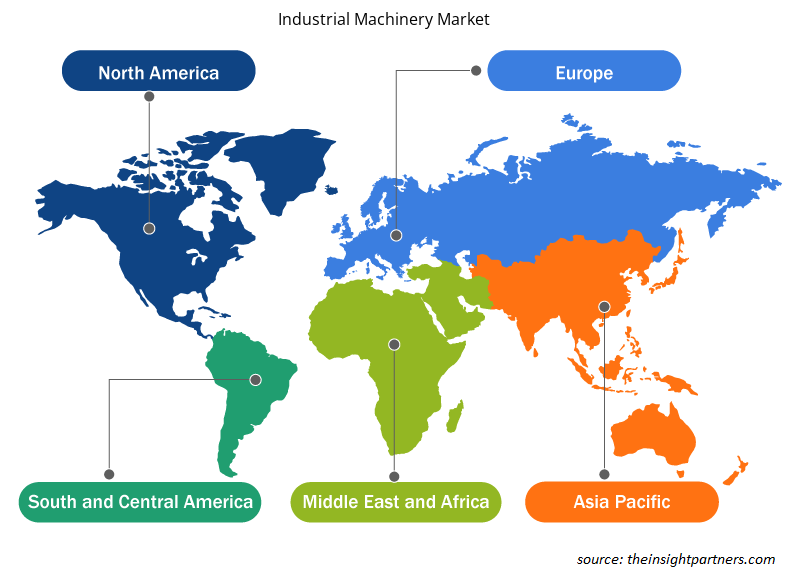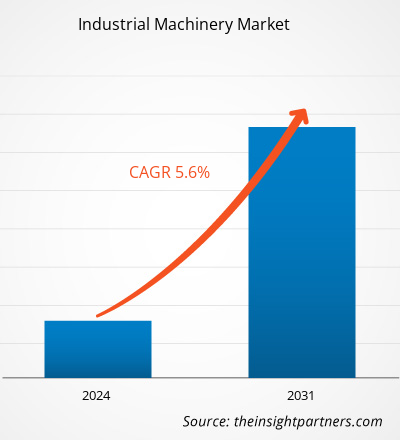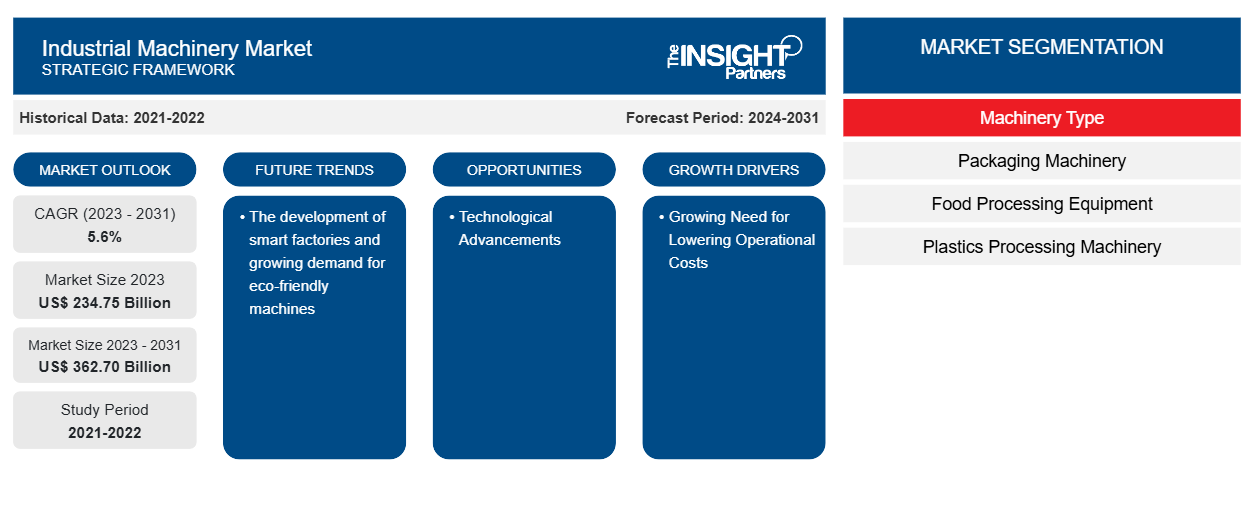Le marché des machines industrielles devrait atteindre 362,70 milliards USD d'ici 2031, contre 234,75 milliards USD en 2023. Le marché devrait enregistrer un TCAC de 5,6 % en 2023-2031. Le développement d'usines intelligentes et la demande croissante de machines respectueuses de l'environnement devraient rester une tendance clé du marché des machines industrielles.CAGR of 5.6% in 2023–2031. The development of smart factories and growing demand for eco-friendly machines is likely to remain a key industrial machinery market trend.
Analyse du marché des machines industrielles
Le marché des machines industrielles connaît une croissance rapide en raison du besoin croissant de réduire les coûts d'exploitation et de l'adoption croissante de machines industrielles dans les secteurs de l'automobile, de l'alimentation et des boissons, de la pharmacie, de la fabrication et d'autres industries. Le marché est en constante expansion, porté par l'urbanisation croissante et l'automatisation industrielle . De plus, les progrès technologiques et l'intégration de l'IA et de la technologie d'impression numérique 3D offrent des opportunités lucratives de croissance du marché.
Aperçu du marché des machines industrielles
Les machines industrielles désignent tout équipement mécanique, électrique ou électronique conçu et utilisé pour exécuter une fonction donnée et produire un résultat spécifique. Les fabricants des usines de fabrication utilisent ces machines pour couper, façonner, former, laminer ou coordonner les processus de production. Les machines industrielles jouent un rôle crucial dans le soutien des activités industrielles dans le monde entier. La numérisation croissante, les avancées technologiques et les initiatives de l'Industrie 4.0 créent des opportunités sur le marché.
Personnalisez ce rapport en fonction de vos besoins
Vous bénéficierez d'une personnalisation gratuite de n'importe quel rapport, y compris de certaines parties de ce rapport, d'une analyse au niveau des pays, d'un pack de données Excel, ainsi que de superbes offres et réductions pour les start-ups et les universités.
-
Obtenez les principales tendances clés du marché de ce rapport.Cet échantillon GRATUIT comprendra une analyse de données, allant des tendances du marché aux estimations et prévisions.
Facteurs moteurs et opportunités du marché des machines industrielles
Le besoin croissant de réduire les coûts opérationnels stimule le marché
Des coûts d'exploitation réduits entraînent des marges plus élevées, ce qui permet aux entreprises de diversifier leur offre de produits et d'accéder à de nouveaux marchés en prenant des initiatives de réduction des coûts. Le besoin croissant des entreprises de réduire leurs coûts d'exploitation augmente la demande de machines technologiquement avancées. Les fabricants intègrent des applications IoT dans ces appareils pour fournir des services améliorés tels que la surveillance à distance, les systèmes de rétroaction centralisés et d'autres fonctionnalités. En outre, les fabricants adoptent également des capteurs améliorés, des applications mobiles et des logiciels intégrés pour rationaliser leurs processus opérationnels en réduisant les coûts globaux de l'entreprise, ce qui stimule le marché.IoT applications into these devices to provide enhanced services such as remote monitoring, central feedback systems, and other features. Moreover, manufacturers are also adopting enhanced sensors, mobile apps, and embedded software to streamline their operational processes by lowering the overall business costs is driving the market.
Progrès technologiques – Une opportunité sur le marché des machines industrielles
Les progrès technologiques rapides devraient stimuler l'innovation sur le marché des machines industrielles au cours de la période de prévision. En outre, les industries manufacturières adoptent des technologies avancées telles que l'intelligence artificielle, l'impression 3D et l'analyse de données volumineuses pour réduire les coûts opérationnels, améliorer la productivité et augmenter les profits. Cependant, l'intégration potentielle de l'impression 3D et de la technologie de l'IA crée des opportunités de croissance pour les acteurs internationaux et nationaux présents sur le marché des machines industrielles.
Analyse de segmentation du rapport sur le marché des machines industrielles
Les segments clés qui ont contribué à l’élaboration de l’analyse du marché des machines industrielles sont le type de machines.
- En fonction du type de machine, le marché des machines industrielles est divisé en machines d'emballage, équipements de transformation des aliments, machines de transformation des plastiques, machines-outils de formage des métaux et machines à bois.
- Français Le segment des machines d'emballage est sous-segmenté en machines de remplissage, machines de palettisation, étiqueteuses, machines d'emballage et autres. Le segment des équipements de transformation des aliments est sous-segmenté en trancheuses et découpeuses en dés, équipements d'extrusion, déposeuses et mélangeurs, équipements de stockage et de réfrigération et autres. Le segment des machines de transformation des plastiques est sous-segmenté en machines de moulage d'inspection, machines de moulage par soufflage, machines de moulage par extrusion et autres. Le segment des machines-outils de formage des métaux est sous-segmenté en machine à pression, machine à cintrer, machine à couler, machine à poinçonner et autres. Le segment des machines à bois est sous-segmenté en tours, rectifieuses, scies à ruban et autres.
Analyse des parts de marché des machines industrielles par zone géographique
La portée géographique du rapport sur le marché des machines industrielles est principalement divisée en cinq régions : Amérique du Nord, Asie-Pacifique, Europe, Moyen-Orient et Afrique, et Amérique du Sud/Amérique du Sud et centrale.
En termes de chiffre d'affaires, la région Asie-Pacifique représente la plus grande part de marché des machines industrielles, en raison de l'augmentation des investissements dans les projets d'infrastructure tels que les transports, l'énergie et le développement urbain. Le besoin croissant d'une variété d'équipements industriels, tels que des machines de construction, des engins de terrassement et des équipements de manutention, alimente le marché de la région.
Aperçu régional du marché des machines industrielles
Les tendances régionales et les facteurs influençant le marché des machines industrielles tout au long de la période de prévision ont été expliqués en détail par les analystes d’Insight Partners. Cette section traite également des segments et de la géographie du marché des machines industrielles en Amérique du Nord, en Europe, en Asie-Pacifique, au Moyen-Orient et en Afrique, ainsi qu’en Amérique du Sud et en Amérique centrale.

- Obtenez les données régionales spécifiques au marché des machines industrielles
Portée du rapport sur le marché des machines industrielles
| Attribut de rapport | Détails |
|---|---|
| Taille du marché en 2023 | 234,75 milliards de dollars américains |
| Taille du marché d'ici 2031 | 362,70 milliards de dollars américains |
| Taux de croissance annuel composé mondial (2023-2031) | 5,6% |
| Données historiques | 2021-2022 |
| Période de prévision | 2024-2031 |
| Segments couverts |
Par type de machine
|
| Régions et pays couverts |
Amérique du Nord
|
| Leaders du marché et profils d'entreprises clés |
|
Densité des acteurs du marché des machines industrielles : comprendre son impact sur la dynamique des entreprises
Le marché des machines industrielles connaît une croissance rapide, tirée par la demande croissante des utilisateurs finaux en raison de facteurs tels que l'évolution des préférences des consommateurs, les avancées technologiques et une plus grande sensibilisation aux avantages du produit. À mesure que la demande augmente, les entreprises élargissent leurs offres, innovent pour répondre aux besoins des consommateurs et capitalisent sur les tendances émergentes, ce qui alimente davantage la croissance du marché.
La densité des acteurs du marché fait référence à la répartition des entreprises ou des sociétés opérant sur un marché ou un secteur particulier. Elle indique le nombre de concurrents (acteurs du marché) présents sur un marché donné par rapport à sa taille ou à sa valeur marchande totale.
Les principales entreprises opérant sur le marché des machines industrielles sont :
- AB Electrolux
- Alfa Laval
- AMADA SARL.
- Groupe GEA
- HAÏTIENS INTERNATIONAUX
- MITSUBISHI INDUSTRIES LOURDES, LTÉE
Avis de non-responsabilité : les sociétés répertoriées ci-dessus ne sont pas classées dans un ordre particulier.

- Obtenez un aperçu des principaux acteurs du marché des machines industrielles
Actualités et développements récents du marché des machines industrielles
Le marché des machines industrielles est évalué en collectant des données qualitatives et quantitatives issues de recherches primaires et secondaires, qui comprennent d'importantes publications d'entreprises, des données d'associations et des bases de données. Voici une liste des évolutions du marché des machines industrielles et des stratégies :
- En novembre 2022, Ingersoll Rand a lancé le marteau pneumatique robuste 135MAX pour les utilisations industrielles. Le marteau pneumatique 135MAX HD est le marteau pneumatique de nouvelle génération qui s'appuie sur les bases établies par le 119MAX pour offrir des performances et une puissance incroyables à un prix accessible, tout en tirant parti d'une gâchette à réglage fin inspirée des légendaires clés à chocs Ingersoll Rand pour plus de précision et des résultats encore meilleurs. (Source : Ingersoll Rand, communiqué de presse, 2022)
Rapport sur le marché des machines industrielles : couverture et livrables
Le rapport « Taille et prévisions du marché des machines industrielles (2021-2031) » fournit une analyse détaillée du marché couvrant les domaines ci-dessous :
- Taille du marché et prévisions aux niveaux mondial, régional et national pour tous les segments de marché clés couverts par le périmètre
- Dynamique du marché, comme les facteurs moteurs, les contraintes et les opportunités clés
- Principales tendances futures
- Analyse détaillée des cinq forces de PEST/Porter et SWOT
- Analyse du marché mondial et régional couvrant les principales tendances du marché, les principaux acteurs, les réglementations et les développements récents du marché
- Analyse du paysage industriel et de la concurrence couvrant la concentration du marché, l'analyse de la carte thermique, les principaux acteurs et les développements récents
- Profils d'entreprise détaillés
- Analyse historique (2 ans), année de base, prévision (7 ans) avec TCAC
- Analyse PEST et SWOT
- Taille du marché Valeur / Volume - Mondial, Régional, Pays
- Industrie et paysage concurrentiel
- Ensemble de données Excel
Rapports récents
Témoignages
Raison d'acheter
- Prise de décision éclairée
- Compréhension de la dynamique du marché
- Analyse concurrentielle
- Connaissances clients
- Prévisions de marché
- Atténuation des risques
- Planification stratégique
- Justification des investissements
- Identification des marchés émergents
- Amélioration des stratégies marketing
- Amélioration de l'efficacité opérationnelle
- Alignement sur les tendances réglementaires























 Obtenez un échantillon gratuit pour - Marché des machines industrielles
Obtenez un échantillon gratuit pour - Marché des machines industrielles